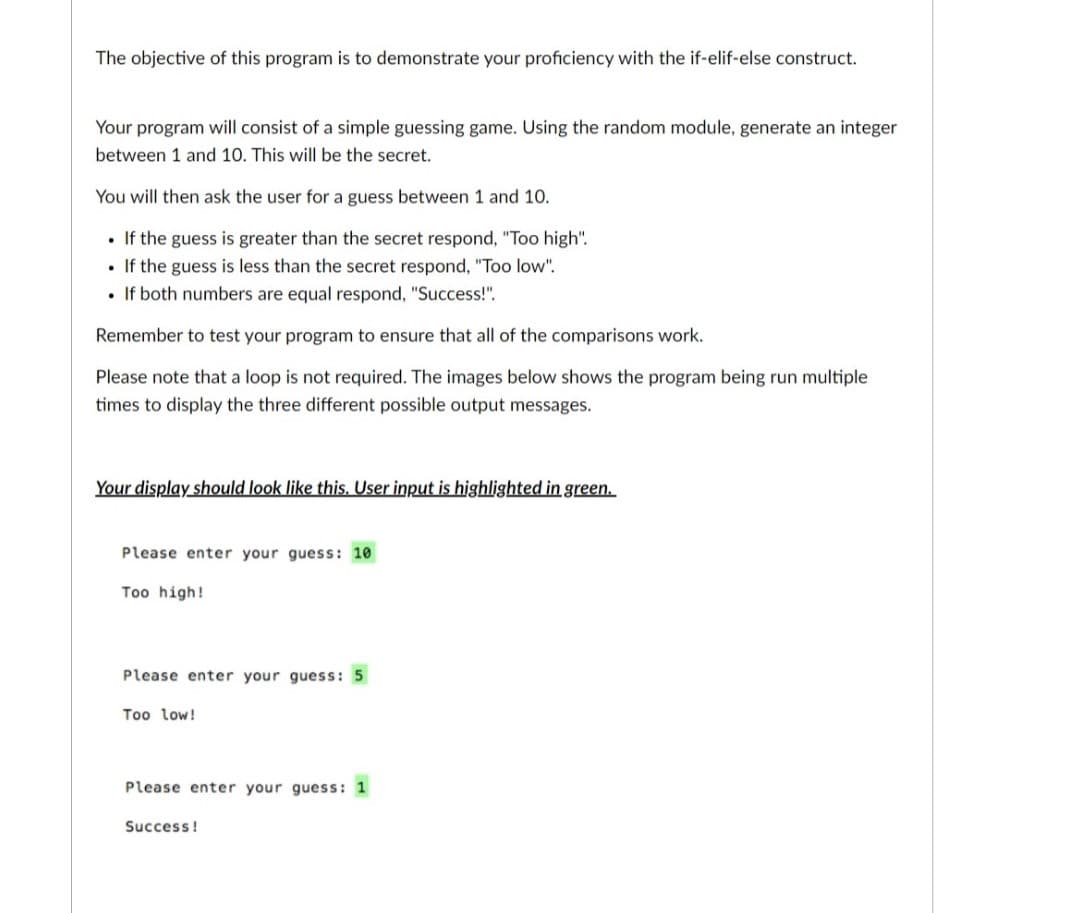The objective of this program is to demonstrate your proficiency with the if-elif-else construct. Your program will consist of a simple guessing game. Using the random module, generate an integer between 1 and 10. This will be the secret. You will then ask the user for a guess between 1 and 10. . If the guess is greater than the secret respond, "Too high". • If the guess is less than the secret respond, "Too low". • If both numbers are equal respond, "Success!". Remember to test your program to ensure that all of the comparisons work. Please note that a loop is not required. The images below shows the program being run multiple times to display the three different possible output messages.
The objective of this program is to demonstrate your proficiency with the if-elif-else construct. Your program will consist of a simple guessing game. Using the random module, generate an integer between 1 and 10. This will be the secret. You will then ask the user for a guess between 1 and 10. . If the guess is greater than the secret respond, "Too high". • If the guess is less than the secret respond, "Too low". • If both numbers are equal respond, "Success!". Remember to test your program to ensure that all of the comparisons work. Please note that a loop is not required. The images below shows the program being run multiple times to display the three different possible output messages.
C++ Programming: From Problem Analysis to Program Design
8th Edition
ISBN:9781337102087
Author:D. S. Malik
Publisher:D. S. Malik
Chapter5: Control Structures Ii (repetition)
Section: Chapter Questions
Problem 15PE
Related questions
Question

Transcribed Image Text:The objective of this program is to demonstrate your proficiency with the if-elif-else construct.
Your program will consist of a simple guessing game. Using the random module, generate an integer
between 1 and 10. This will be the secret.
You will then ask the user for a guess between 1 and 10.
. If the guess is greater than the secret respond, "Too high".
• If the guess is less than the secret respond, "Too low".
. If both numbers are equal respond, "Success!".
Remember to test your program to ensure that all of the comparisons work.
Please note that a loop is not required. The images below shows the program being run multiple
times to display the three different possible output messages.
Your display should look like this. User input is highlighted in green.
Please enter your guess: 10
Too high!
Please enter your guess: 5
Too low!
Please enter your guess: 1
Success!
Expert Solution
This question has been solved!
Explore an expertly crafted, step-by-step solution for a thorough understanding of key concepts.
Step by step
Solved in 4 steps with 2 images

Follow-up Questions
Read through expert solutions to related follow-up questions below.
Knowledge Booster
Learn more about
Need a deep-dive on the concept behind this application? Look no further. Learn more about this topic, computer-science and related others by exploring similar questions and additional content below.Recommended textbooks for you

C++ Programming: From Problem Analysis to Program…
Computer Science
ISBN:
9781337102087
Author:
D. S. Malik
Publisher:
Cengage Learning

EBK JAVA PROGRAMMING
Computer Science
ISBN:
9781337671385
Author:
FARRELL
Publisher:
CENGAGE LEARNING - CONSIGNMENT

C++ Programming: From Problem Analysis to Program…
Computer Science
ISBN:
9781337102087
Author:
D. S. Malik
Publisher:
Cengage Learning

EBK JAVA PROGRAMMING
Computer Science
ISBN:
9781337671385
Author:
FARRELL
Publisher:
CENGAGE LEARNING - CONSIGNMENT